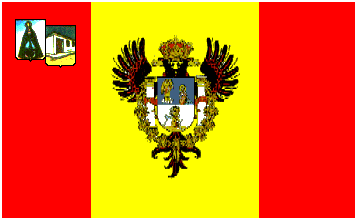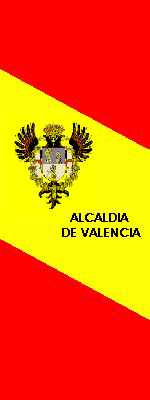 (2:3)
(2:3)by Guillermo T. Aveledo, 22 October 2003

Last modified: 2004-08-07 by dov gutterman
Keywords: carabobo | valencia |
Links: FOTW homepage |
search |
disclaimer and copyright |
write us |
mirrors
 (2:3)
(2:3)
by Guillermo T. Aveledo, 22 October 2003
See also:
Flag of Valencia is
available at <www.valencia2002.com>.
Dov Gutterman, 2 April 2003
Valencia is one of the most important industrial cities of my
country: it's located on the Center North of Venezuela and is the
Capital of Carabobo State.
Raul Jesus Orta Pardo, 2 April 2003
I can't distinguish the objects on the crimson vertical fringe
of the flag's fly on <www.valencia2002.com>,
so those are missing from my above image.
Guillermo T. Aveledo, 19 April 2002
The Flag - Attributes and Semiology: Consists of a field with
approximated ratio 2:3; this is, square and half of length
vertically divided in three stripes: a yellow one on the center
occupying 2/4 parts of the field and two reds, one to the hoist
and the other to the fly occupying the rest 2/4 parts. Completes
the design the Municipality Coat of Arms on the center an two
escutcheons French shaped at the cantón on the hoist red stripe:
one with the image of Our Lady of Socorro (Succour) and another
one with a colonial facade slightly descended with respect to the
previous one. Even though it seems to be inspired on the Flag of
Spain, the official description determines that the yellow stripe
remembers the radiating light of the sun which appeared when
concluding the Battle of Carabobo on June 24th, 1821,
illuminating the definitive independence of the Venezuelan Mother
country. The red stripes symbolizes the heroic blood spilled by
the Valencians patriots during the sites which underwent Valencia
on March and Juy of 1814. The Coat of Arms reaffirms the
municipal identity. The image of Our Lady of Socorro raises this
Marian invocation as secular Matron of the people, the city and
the Arquidiocese of Valencia alluding to its religious spirit.
The colonial facade represents the so called "Casa de la
Estrella" (the Star's House): historical place where was
signed the first National Constitution of the Republic of
Venezuela and its separation of Great Colombia.
Historical Synthesis: It was created by Professor Pedro Gramcko.
Coat of Arms - Attributes: Consist in an Hispanic shape divided
per fess. The Quarter of the Chief enameled in Azure (blue)
reproduces the scene of the Announcement with the Holiest Virgin
postroad to the sinister and the Archangel Saint Gabriel to her
dexter, both in their colors. The Quarter of the Base enameled in
Argent (white) reproduces the image of Saint John the Baptist
terraced in its colors. As external ornaments the blazon shows a
extended and bicephalous eagle in Sable (black), with delineated
pens in Gules (red) and crowned put behind to the field holding
with its claws two Jonic columns in Or (yellow) and Argent
(white) laced with pennants of Gules (red) that loads as mottoes
the Latin inscriptions "PLUS" (More) to the dexter
"ULTRA" (There) to the sinister, all rounded by the
Great Cord of the Orden Toisón de Oro (Order of Golden Fleece).
Semiology: Its configuration exposes that probable and
unofficially these Arms derives from the Imperial ones of Charles
I of Spain and V of Germany. The First Quarter emphasizes the
invocation of Our Lady who was dedicated to Valencia from its
foundation which is commemorated on March 25th, the Announcement
Day. The Second Quarter reminds the town of Borburata at which
arrived the first settlers of Valencia and whose Patron, Saint
John the Baptist, have been and continuous being venerated by the
Venezuelan coast's inhabitants; in addition, the image of this
Saint has been present since remote times on the Coat of Arms of
the city, according to testify acts of the Municipal Councill and
old inhabitants of the place. The eagle under this configuration
remembers the House of Austria (Hapsburg) that reigned on Spain
between 1517 (Charles I of Spain and V of Germany) and 1665
(Charles II of Spain) soon to be happened by House of Borbón,
ruling at the moment. The crown alludes to the kingdom of Spain.
The columns reminds the so called "Pilares de Hercules"
(Hercules Pillars) on the Strait of Gibraltar, place where
concluded the world according to belief of the old Romans. The
original motto was "NON PLUS ULTRA" (Not more there')
until Charles I of Spain commanded to omit the word
"NON" in order to indicate that his kingdom extended
beyond the "Pillars". The Great Cord of the Golden
Fleece, Order established by Spaniard king Felipe "El
Bueno" (Phillipe, called "the Good") seems to
evoke the classic legend of the Golden Fleece: legendary lamb
whose wool was golden and to which were attributed extraordinary
powers that arrived at hands of Jason, captain of the Argos and
its Argonauts: although its presence in this Coat of Arms is
discussed because is granted exclusively by the Spanish monarch,
it can be considered legitimate because embellishing the
Valencian Arms since its first well-known representation. Doesn't
fit doubt about the ancient Hispanic root of Valencia which
reveal the ornaments of this blazon.
Historical Synthesis: Its first well-known illustration dates
since 1804 although doesn't know its origin. It happened through
a period of latency until was rescued by Sr. Oswaldo Feo
Caballero and Dr. Julio Centeno, Jr., being based on acts of the
Municipal Council of Valencia; the historical contributions of
Mr. Sr. Rafael Saturno Guerra, First Official Chronicler of
Valencia and Don Enrique Bernardo Núñez, First Official
Chronicler of Caracas and the artistic contribution of Professor
Pedro Gramcko.
Sources: Bulletin elaborated by Dr Guillermo
Mujica Sevilla, Municipal Chronicler, emitted by the Council of
Valencia Municipality and provided by Prof. Julio César Centeno
Rodriguez, Chronicler of San Diego Municipality, November 2001.
Raul Jesus Orta Pardo, 22 October 2003
Charles II (and the Spanish Hapsburg branch with him) reigned
until 1700. Philip the Good was not a Spanish king - his
descendant Philip the Handsome was (but did not establish the
Order, only introduced it in Spain). It was not exclusively since
the Austrian Hapsburgs continue(d) to do so.
Santiago Dotor, 6 November 2003
The Device
g)val.gif)
by Guillermo T. Aveledo, 22 October 2003

by Guillermo T. Aveledo, 19 April 2002
This is an image which I did after visiting Valencia in
Christmas several years ago, with my notes of Valencian banners
that the mayor office had placed, hoistings it in each post of
light of the most centric avenues of the city.
Guillermo T. Aveledo, 19 April 2002
g-val.gif)
by Guillermo T. Aveledo, 19 April 2002
Based on <www.alcaldiadevalencia.gov.ve>.
Guillermo T. Aveledo, 19 April 2002